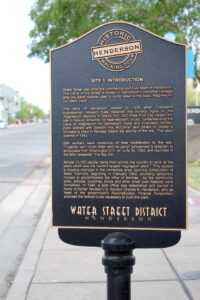Henderson Walking Tour – Site 1
henderson, nv
Discription:
Henderson Walking Tour – Site 1: Magnesium Plant Memorial, Introduction. (Henderson Historic Walking Tour Site. Number One: Introduction.) Number One in a series of five walking tour markers, or guideposts, on sidewalks in and around Henderson’s Water Street District. Each one has a title and gives a brief history of the particular surrounding area. Only three of them (one, three, and five) are specific to honoring Henderson’s contribution to the military and veterans. Site Number One describes in some detail the development of Basic Magnesium Inc.
(BMI), which processed the deposits for use in making lightweight metal and incendiary bombs for America in WWII. Businessman Howard Eells obtained mineral rights to magnesium deposits in Gabbs, NV, 350 miles from Las Vegas. He worked with Sen. Pat McCarran and others to create a processing plant in Henderson. Almost 15,000 individuals came from across the nation to work at the “world’s largest magnesium plant.” The need for housing the workers led to the Basic Townsite, later named for U.S. Sen. Charles B. Henderson, who as head of the government’s Reconstruction Finance Corp. provided federal funds to build the plant. A telegram sent from Washington, D.C. on June 25, 1942, proclaimed, “Together we’ll crush Hitler and his gang!
Responcible Organization/Individual:
City of Henderson
Designed By:
City of Henderson

Address:
240 S. Water Street. Henderson NV 89015
GPS Coordinates:
Hours Available
Ceremonies: no
History:
At the heart of Henderson, the story is the Water Street District which began as the city’s original “Main Street” back in the 1940s. During World War II, the Basic Magnesium Plant was built in the desert between Boulder City and Las Vegas to supply the metal needed for munitions and airplane parts. A small town grew up to the house and supply the plant’s 14,000 employees When the war ended, the town almost ended also. In 1947, the federal government planned to sell the entire town as war surplus property. However, the Nevada Legislature wasn’t ready to give up and managed to save it. The town that refused to die was incorporated in 1953 with 13-square miles of land and about 7,400 residents. Today it has grown into Nevada’s second-largest city.